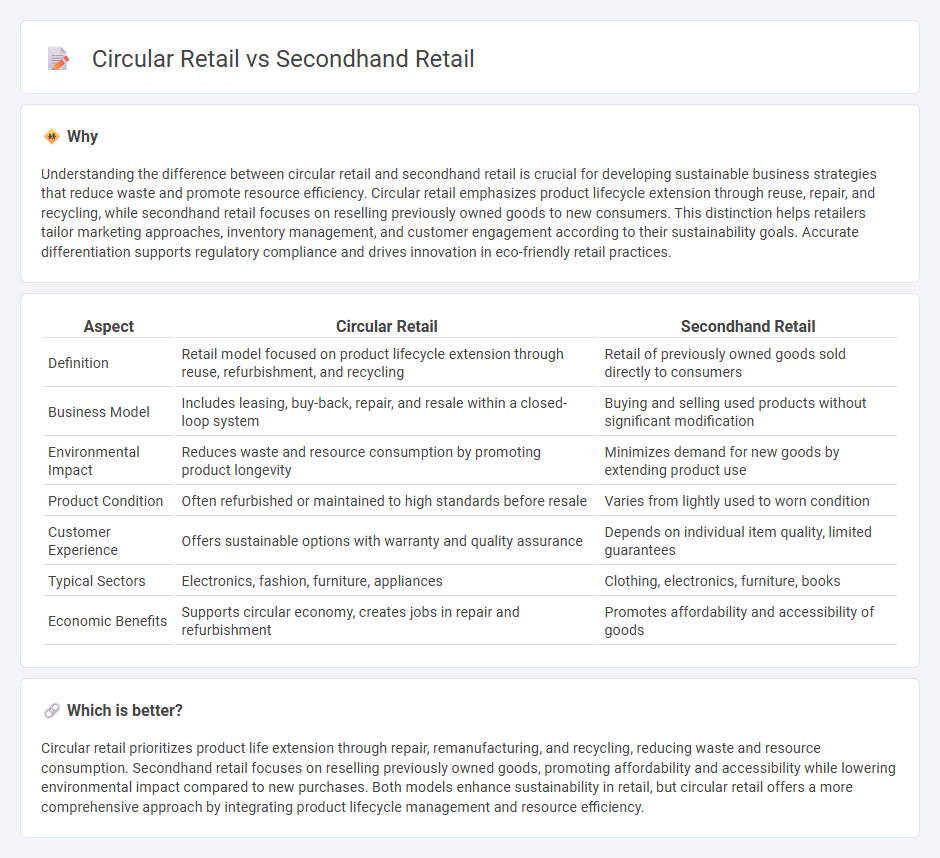
Circular retail focuses on creating closed-loop systems where products are redesigned, reused, and recycled to minimize waste and environmental impact. Secondhand retail centers on reselling pre-owned goods, extending product life cycles and offering budget-friendly alternatives to new items. Explore the key differences and benefits of circular retail versus secondhand retail to understand their roles in sustainable consumption.
Why it is important
Understanding the difference between circular retail and secondhand retail is crucial for developing sustainable business strategies that reduce waste and promote resource efficiency. Circular retail emphasizes product lifecycle extension through reuse, repair, and recycling, while secondhand retail focuses on reselling previously owned goods to new consumers. This distinction helps retailers tailor marketing approaches, inventory management, and customer engagement according to their sustainability goals. Accurate differentiation supports regulatory compliance and drives innovation in eco-friendly retail practices.
Comparison Table
| Aspect | Circular Retail | Secondhand Retail |
|---|---|---|
| Definition | Retail model focused on product lifecycle extension through reuse, refurbishment, and recycling | Retail of previously owned goods sold directly to consumers |
| Business Model | Includes leasing, buy-back, repair, and resale within a closed-loop system | Buying and selling used products without significant modification |
| Environmental Impact | Reduces waste and resource consumption by promoting product longevity | Minimizes demand for new goods by extending product use |
| Product Condition | Often refurbished or maintained to high standards before resale | Varies from lightly used to worn condition |
| Customer Experience | Offers sustainable options with warranty and quality assurance | Depends on individual item quality, limited guarantees |
| Typical Sectors | Electronics, fashion, furniture, appliances | Clothing, electronics, furniture, books |
| Economic Benefits | Supports circular economy, creates jobs in repair and refurbishment | Promotes affordability and accessibility of goods |
Which is better?
Circular retail prioritizes product life extension through repair, remanufacturing, and recycling, reducing waste and resource consumption. Secondhand retail focuses on reselling previously owned goods, promoting affordability and accessibility while lowering environmental impact compared to new purchases. Both models enhance sustainability in retail, but circular retail offers a more comprehensive approach by integrating product lifecycle management and resource efficiency.
Connection
Circular retail and secondhand retail are interconnected through their shared focus on extending product lifecycles and minimizing waste in the retail industry. Circular retail emphasizes product reuse, refurbishment, and recycling, creating closed-loop systems that reduce environmental impact. Secondhand retail supports this model by offering consumers access to pre-owned items, promoting sustainable consumption and reducing demand for new products.
Key Terms
Recommerce
Secondhand retail involves reselling used goods directly to consumers, while circular retail emphasizes closed-loop systems designed to maximize product lifespan through reuse, refurbishment, and recycling. Recommerce, a subset of circular retail, specializes in efficiently buying and reselling pre-owned products, leveraging digital platforms and data analytics to optimize inventory and customer reach. Explore the latest strategies and technologies driving the growth of recommerce in modern retail markets.
Product Lifecycle
Secondhand retail extends the product lifecycle by reselling pre-owned items, reducing waste and promoting sustainability. Circular retail integrates repair, refurbishment, and resale within a closed-loop system to maximize product longevity and resource efficiency. Explore how businesses optimize product lifecycle management through innovative circular retail strategies.
Refurbishment
Secondhand retail involves selling previously owned products as-is, while circular retail emphasizes refurbishment to restore items to optimal quality, extending their lifecycle and reducing waste. Refurbishment includes thorough cleaning, repairs, and quality testing, ensuring products meet higher standards than typical secondhand offerings. Explore the benefits of refurbishment in circular retail to understand its impact on sustainability and consumer trust.
Source and External Links
Second-hand shop - Wikipedia - A secondhand shop sells used goods and is a part of the circular economy, with formats ranging from antique stores to thrift and charity shops where donated items are sold to support charitable causes.
Sell Your Clothes, Shop, Repeat. Crossroads Trading - Crossroads Trading operates physical stores offering on-trend secondhand clothing and accessories for sale, trade, or cash across multiple U.S. locations.
ThredUp | An Online Consignment & Thrift Store - ThredUp is an online consignment and thrift store enabling customers to buy and sell high-quality secondhand clothes from popular brands at significant discounts while promoting sustainable fashion.
 dowidth.com
dowidth.com